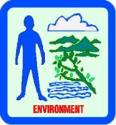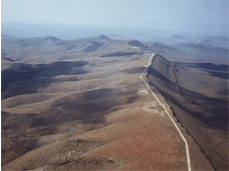| Click above, for articles in
this issue.
 The Yucca Mountain
Plan The Yucca Mountain
Plan
 Source: DOE Source: DOE
Yucca Mountain, Nevada
The dilemma of what to do with spent nuclear material has been debated since
the 1950's, without an effective resolution to the problem being arrived at by
the U.S. government, seemingly until recently. According to the Department
of Energy, 131 sites around the nation possess spent nuclear fuel, which needs
to be disposed of in a safe manner. The nuclear material has been used in
nuclear power plants to produce electricity, as well as in the
fabrication of nuclear armaments. Back in 1956, the National Academy of
Sciences recommended that 'deep geologic disposal, buried amid salt deposits'
would be the best method to safely dispose of nuclear waste. By
1960, such a plan was about to be implemented in Lyons, Kansas, but was later
abandoned since it was discovered that the area was riddled with old oil and gas
exploration bore holes.
It took another 22 years before Congress finally approved a nuclear
policy waste management plan, which was projected to be implemented by
1998. A proposed list of final sites for the disposal had
been selected in 1987. After much discussion, in 1993, the Department of Energy (DOE)
formulated a new Program to set waste acceptance by 2010, pushing up the date to
start disposal by twelve years, but still had not selected the final site.
Finally in 2002 President Bush accepted the DOE's recommendation of
Yucca Mountain as the depository site for nuclear wastes. The site
selected did not sit well with the State of Nevada, whose governor initiated
litigation to stop the development of the depository. But earlier this
year, the U.S. Court of Appeals rejected the suit. Yucca Mountain
has therefore been cleared to accept radioactive material for a
duration of 24 years, accomodating a total of 70,000 tons of nuclear
waste. The waste must remain buried for the next 10,000 years, which is
how long it will take for total decay, thereby rendering it harmless.
According to Mike Voegele, the chief scientist at Yucca Mountain, the
material will be encased in steel drums lined with lead, but can only be moved
by remote controlled equipment. The drums will be so hot that they will
generate an ambient temperature of 300 degrees Fahrenheit.
The DOE maintains that disposal of the material is a top priority since
currently approximately 160 million Americans live within a 100
mile radius to some site that is temporarily storing spent nuclear
material. That material is being housed in cooling tanks, or ponds, and
needs to be moved as soon as possible. The material is set to be trucked
through the nation's highways as well as by rail to Yucca Mountain on a daily
basis. According to the DOE between 1 and 6 such shipments will be
initiated every day during 24 years. Critics of the Yucca Mountain plan,
cite the obvious; " how many accidents will inevitably happen during these
daily shipments ? How many people, ordinary people, are going to be
exposed to this menace ? What sense does this make ? Are we
diminishing a danger or are we compounding it ? And how long will those
steel drums remain sealed before they begin to leak; 50 years, 75 years, 100
years ? What will Americans in the mid west do for the next 10,000 years,
to escape the danger ? "
Most of the shipments from the East Coast will need to be routed through
Chicago, within a mile of Lake Michigan. Yucca Mountain is 90 miles
northwest of the city of Las Vegas, in a remote desert on federal land.
L.M. / Contributing Correspondent
Posted October 26, 2004
URL:
www.thecitizenfsr.org
SM
2000-2011
You are here: HOME page-OLDER ISSUES-OCTOBER 2004 -Environment
Previous : Current Events Next : Eye on Human Rights
|